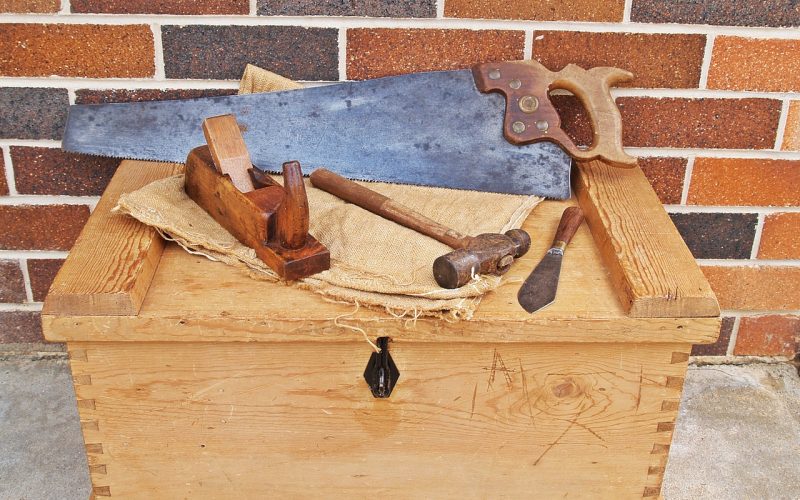Browsing your local hardware store can be pretty intimidating due to the different types of hand saws available.
Some options are incredibly versatile, but the majority are highly specialized for particular kinds of materials or woodworking tasks.
Any saw powered by the user’s force rather than electricity, a battery, or gas is called a hand saw.
These saws are frequently used in various trades and can be used for multiple tasks in the home and garden.
These saws are more affordable than power saws, easily transportable, and take up very little storage space.
However, they frequently take longer to complete a task than a powered equivalent, so they might be best suited for smaller jobs.
Whether you work as a carpenter, a woodworker, or a lumberjack, this guide will help you identify the hand saw type that best serves your needs.
Please read on as we discuss some of the different types of hand saws available in the market.
1. Hack Saw
The hack saw’s thin blade makes it ideal for cutting through thin materials like plastic or metal pipes, despite its original purpose of cutting through metal.
It could be used as a multi-purpose saw to cut through the wood occasionally, but it could harm the blade.
This saw maintains tension across a C-frame while using a fine-toothed blade that typically has between 18 and 32 teeth per inch.
Also, the hack saw is one of the most popular types and a crucial hand tool for small DIY projects around the house.
2. Coping Saw
Like the hack saw, the coping saw has a blade held in place by tension. It got its name because it is best used to make coping joints rather than miter joints when cutting curves into the wood.
These saws have blades with few teeth—between 15 and 17 per inch. These saws are small and usually have a diameter of six inches. This is one of the different types of hand saws.
3. Crosscut Saw
This saw is made to cut against the wood grain and create rough cuts of wood, such as trimming branches or cutting lumber (i.e., perpendicular to the grain).
Because of their wide teeth and relatively thick blades, crosscut saws are rigid against rough wood. A single person or two people can operate them at once.
Furthermore, the two-person crosscut saws, also known as lumberjack saws, have handles on either end.
They are excellent for slicing backyard planks to size and might be helpful while camping.
4. Bow Cut Saw
A contemporary crosscut saw is a bow-cut saw. It is a medium-sized hand tool primarily used to cut logs and prune trees.
Crosscut teeth on a bow-cut saw can remove sawdust while being pushed in and out.
Because of their relatively long and narrow blades, they are suitable for cutting thick pieces of wood. You can also make curved cuts with them.
5. Fret Saw
These saws are made to handle much more complex woodworking. The word “fret” is derived from the French word “freter,” which means “lattice,” as this saw was designed to be used on latticework.
With about 32 teeth per inch, the blades of this tool are exact and capable of producing accurate work, but they are also brittle. Like coping saws, fret saws can make curved cuts, but coping saws are much less accurate than fret saws.
6. Keyhole Saw
These saws have a blade pointed at the opposite end of a single handle, giving them the appearance of a dagger. Because of their ability to jab through materials like drywall and saw-through, they are also known as “jab saws.”
Due to their thin blades, they are perfect for making tricky cuts or tiny holes. They are also employed for rough pattern cutting.
Also, these saws are typically available with either a fixed or retractable blade. This is one of the different types of hand saws.
7. Japanese Saw
A handle is joined to a robust and narrow blade at one end of a Japanese saw. Unlike most other saws, which cut on the push motion, these are made to cut on the pull motion.
This has the advantage of a neater, more precise cut. Although these saws are made for smaller, more straightforward jobs, they are also said to offer greater control. In contrast, a push saw would allow the user’s weight to support the blade as it cuts harder materials.
8. Rip-Cut Saw
One of the most typical saws that anyone who works with wood will own is a rip-cut saw. Because of its adaptability and suitability for various tasks, it is likely the saw used most frequently. The purpose of a rip-cut saw is to cut wood against the grain.
Moreover, it has fewer teeth per inch than most other hand saws, but each tooth is highly sharp to remove wood chips as it works, almost like a group of chisels working simultaneously.
9. Back Saw
These saws are also known as dovetail saws because they are suitable for creating precise and accurate dovetail joints. Because of their fine teeth and narrow blades, they are ideal for precise cuts.
Back saws benefit from having a rigid metal plate made of steel or brass attached to the side of the cutting edge opposite the blade. As a result, they have better control and can use less force when cutting.
10. Pruning Saw
These saws are made especially for gardens, where they can quickly and efficiently prune trees and big shrubs. They can easily reach even difficult-to-reach branches concealed among densely growing trees and have a single curved handle attached to a curved blade.
Furthermore, pruning saws are an excellent tool for smaller pruning jobs when a chainsaw is unnecessary because they have many more teeth per inch than saws of comparable size. This is one of the different types of hand saws.
11. Veneer Saw
These saws are made to cut laminates, plastics, and hardwood veneers. They have a small, curved, double-edged blade that is usually only 3 or 4 inches long.
They are only helpful for working on small areas due to their size, but they produce results quickly and smoothly. Also, these saws typically have 13 teeth per inch of blade.
The veneer saw can perfectly cut materials with square edges and a straight edge to produce butt joints for matching veneers.
12. Wallboard Saw (Drywall Saw)
These saws, also called drywall saws, greatly resemble keyhole saws. However, wallboard saws typically have shorter, wider blades, which makes a difference.
Their blades frequently have two edges and are covered in sharp teeth on both the top and bottom. These saws drill holes into paneling or drywall and have a pointed nose. They are best for rough cuts because they typically have fewer teeth per inch than a keyhole saw.
13. Folding Saw
There are many different sizes and shapes of folding saws. Their main distinguishing characteristic is the pivot point that allows the saw to fold in half and have the blade fit inside the handle. This makes the saw incredibly portable and convenient to store or move.
Pruning saw blades are frequently found on folding saws. Furthermore, a folding saw works best when camping to cut thin branches or logs. This is one of the different types of hand saws.
14. Compass Saw
Curved cuts are made with a compass saw, especially in hard-to-reach places. The blade can fit through narrow openings because of its length, thinness, and sharp point. The handle typically has a pistol grip and is made to cut through drywall or soft wood.
A compass saw resembles a keyhole saw but has a longer blade and can cut through more rigid materials.
A compass saw has either retractable or detachable blades. Its best applications are curved cuts in softwoods and tight spaces.
15. Pit Saw
Pit saws have a long, stiff blade that can reach 14 feet and are initially used in saw pits (Source). The top man, a second lumber worker, controls the saw while holding the handle and standing above the log; the pit man frequently guides the blade from below.
The teeth are made to cut during the pushing motion. A two-person team using a pit saw is best suited for sawing large lumber in a saw pit.
16. Two Man Saw
Before the development of the chainsaw, two-person forest saws were widely used for logging and felling operations. They can range from 4 to 12 feet and have handles on both ends.
Because the teeth can cut in both directions, both sawyers can put forth the effort. They are used in conjunction with felling wedges to remove wood chips.








